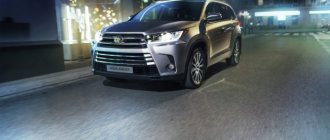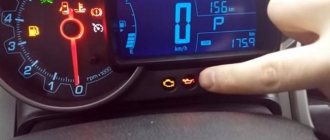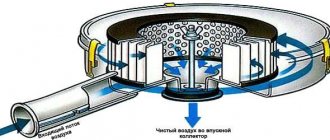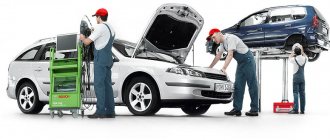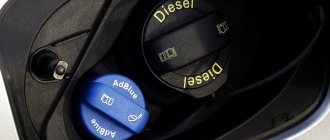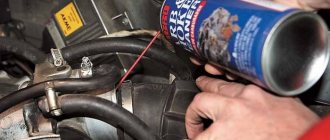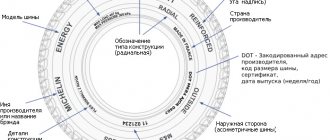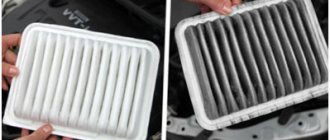No one is immune from the fact that even with the most careful operation of the car, one or another failure will occur in the operation of one of its systems. To provide visual control over the main parameters of the motor and related components, a visual tracking system is provided. The so-called control indication allows you to react in a timely manner to engine malfunctions, thereby protecting it from more serious damage.
One way or another, a warning light that suddenly flashes on the instrument panel only notifies the driver that the control system has detected a malfunction. The system only signals a breakdown, but does not allow us to judge the specific location and cause of the problem.
The simplest and most reliable way to determine the causes of the Check Engine light coming on is to diagnose the car using specialized devices. But a trip to the service is not a cheap pleasure and there are not always specialized stations nearby “what will you do if the error lights up on the road, far from the city?”
At the moment, on the automotive goods market, there is a wide range of diagnostic equipment at quite affordable prices, starting from 1,000 rubles.
These devices are convenient because you don’t need to carry a computer with you to work with them; they connect to any Android, iOS and Windows smartphone and are connected via wireless communication channels - Bluetooth or Wi-Fi. Among such devices, we can highlight the most optimal adapter in terms of price, functionality and stability - the Scan Tool Pro (Black Edition) autoscanner.
According to our personal experience, the device copes with its purpose perfectly, displaying on the smartphone screen all available error codes for all vehicle systems, with a detailed decoding and the ability to reset them, and also shows detailed information about the car (VIN number, actual mileage, operation sensors and much more). We recommend that every car owner equip himself with a device of this type; the cost of such devices is usually recouped in one or two trips to the station.
Among all other visual warning indicators, a special place is occupied by the engine failure indicator. In this case, a prompt solution to the problem will be required. Otherwise, there is a high probability that the engine will simply fail.
What actions should be taken if the Check Engine light comes on? Let's try to understand this in more detail.
What does it look like
An illuminated check engine light on a vehicle looks like a yellow or red “video camera” without an exclamation point, with the words Check Engine displayed inside or next to it. The indicator lights up on the car's dashboard (on the display behind the steering wheel). A photo of a picture with a receipt icon in a car is presented below.
Check badge in the car
The yellow “Check Engine” icon means that the car owner needs to independently change something in the car control system or take the car to a service station.
A red indicator may indicate a serious breakdown. Driving by car is strictly not recommended. The car needs to be taken to the service station urgently.
If the engine light is on in the car, then there are definitely the following faults:
- low-quality gasoline or other fuel is poured into the tank;
- spark plugs have failed;
- the integrity of the ignition system coil winding is damaged;
- there is a short circuit in the engine;
- The residual oxygen sensor (lambda probe) stopped working;
- the injectors are clogged;
- the catalyst does not work.
The Check Engine icon only blinks intermittently in the following situations:
- When the engine triples (not all the fuel burns). The check sign in the car lights up when a spark is missed. Unburnt fuel is discharged through the exhaust manifold.
- In case of critical wear of the catalytic converter. As a result, the car cannot be used.
- If the engine ECU fails.
The exact cause of a car breakdown can only be found out by diagnosing the ECU with an OBD 2 scanner or at a service station.
What to do when the check light is on in the car: conclusions
Above, we examined what a check engine is and identified the reasons why this indication starts to work. It is important to remember that the operation of the indication coincides with the incorrect behavior of the motor, which can often be felt without diagnostic devices. By comparing changes in the operation of the power unit with the check engine indication, you can independently determine where to look for malfunctions: cooling system, oil level, fuel supply or ignition problems.
It should also be said about the vulnerability of not only the self-diagnosis system. The ECU may also not work correctly, making errors when receiving information about the state of the engine. Therefore, it may also be the reason why the check engine light came on. Only specialists can cope with such a problem, because the reason for poor functioning of the ECU can be associated with both hardware damage and firmware.
To avoid this indication after the engine is started, you should regularly monitor the performance of the cooling system and prevent the oil level from decreasing. Also, you should not allow the spark plugs to become dirty, and you should not allow yourself to skimp on the quality of fuel. Attempts to save on consumables often result in serious technical problems for the car, and the check engine warning light will always remind you of this, irritating the driver. At every car maintenance, it is recommended to diagnose the ECU to ensure correct operation.
What does it mean
Check Engine is translated from English as “check the motor (engine).” The error code is indicated as follows: P0102… P0616.
The first letter of the error code identifies one of the car systems in which the breakdown occurred. There can be 4 codes in total:
- P - gearbox and/or engine;
- U - CAN bus;
- C - chassis;
- B - airbags, electric windows, central locking.
The second character after the letter indicates the type of error. The breakdown can be general (the same for all OBD II engines) or specific (for a specific car).
When the check icon appears
The second character of the error code is indicated by the following numbers:
- 0 - OBD 2 code;
- 1, 2 — manufacturer code;
- 3 - Reserved SAE (reserve).
The third character of the error code is the car subsystem where the failure occurred. The following numbers may appear on the receipt icon in your car:
- 1, 2 - injector circuit, fuel pump, fuel tank or air supply system;
- 3 - ignition system;
- 4 — auxiliary system (control);
- 5 — car speed, idle;
- 6 - ECU and its external circuits;
- 7, 8 — gearbox;
- 9, 10 - reserve.
The fourth and fifth characters of the error code indicate its serial number.
Why does the “check” light up: the most common and common malfunctions
So, we figured out the general scheme. Now let's look at what problems lead to the check light coming on and the engine stalling. Often a p0300 error occurs, which indicates that a misfire (misfire) is occurring. There are several reasons for these omissions, and to determine them it is necessary to carry out a step-by-step diagnosis, taking into account certain individual symptoms.
- You should start by checking the ignition system. The most common cause of tripping is the failure of spark plugs and armored wires. Candles can wear out their service life, break down, or become heavily contaminated. Armored wires suffer from insulation damage and breakdowns. One way or another, the result is either no spark at all, or there is a spark, but it’s weak.
If everything is in order with the spark plugs and wires, you should pay attention to the ignition module or ignition coils, which may be shorting. In this case, it is better to entrust the check to experienced specialists, since unprofessional actions lead to the fact that you can burn the switch or damage other important elements.
It should also be added that you need to carefully inspect the spark plug wells themselves. Quite often, the engine fails if water accumulates in the wells or engine oil gets there. In some cases, lubricant gets into the wells due to problems with the valve cover gasket.
- Having dealt with the ignition system, it is necessary to check the power system. As a rule, incorrect operation of injection nozzles or malfunctions in their operation lead to engine tripping. At the same time, the check will light up or flash.
The best option would be to check the injectors on a special stand. Such diagnostics allows you to determine the need to clean, repair or replace injectors. At the same time, specialists check the power supply to the injectors, the condition of the injector O-rings, etc.
- As for compression, a burnt-out valve often leads to an unexpected decrease in the indicator. If the valve burns out, the engine starts to run rough. In this case, tripling is constant and occurs in all modes of engine operation. Engine thrust drops significantly, and significant excess fuel consumption is observed.
Please note that in this case you cannot drive the car, as there is a high risk of damaging the catalyst and oxygen sensor (lybda probe). To confirm the diagnosis, you need to measure the compression, and to solve the problem itself, you need to remove the cylinder head, troubleshoot the head and change the valve.
How serious can the reasons be?
Each signal on the car panel is an indicator that the driver must be attentive. When the check engine light comes on, there are several reasons.
- A common cause is gasoline. Due to the additives that unscrupulous manufacturers use in gasoline, the engine does not work properly and becomes clogged. You should change the fuel or refuel at another gas station, and everything works correctly.
- Faulty spark plugs.
- Broken ignition coil.
- A faulty oxygen sensor (lambda probe).
- Broken exhaust catalyst.
- Incorrect operation of high-voltage conductors.
- Malfunction of injectors.
- Fuel pump or fuel filter.
The check should begin with the fuel tank filler cap. If it is not tightened completely or there are defects on it, then the light indicates that the engine is not operating properly.
Each of the reasons is not very scary, but requires immediate elimination. If you do not pay attention in time and do not diagnose the malfunction, you can lead to complete engine failure and incapacity of the machine.
The engine is serious business, but the job doesn't necessarily require a major overhaul or engine replacement. The work of the craftsmen is important in any matter of diagnosing and repairing the engine. But, if the reason is candles, then the replacement is carried out independently and quickly, without the involvement of specialists.
How to redeem a badge
The Check Engine icon remains on the vehicle's dashboard as long as there are still error codes in the OBD system's memory. After the fault is repaired, the codes are erased using a diagnostic tool. You can also extinguish the check icon in the car by disconnecting the terminals from the battery (for 3-5 minutes).
The easiest way in this case is to use a personal scanner. There are quite a lot of similar devices on the market, and an inexpensive car scanner will cost less than one visit to a service station. For example, we can recommend the multi-brand diagnostic scanner Rokodil ScanX.
The advantage of this model is that it is compatible with most cars produced in 1993 with an ODB2 connector. The scanner connects to any iOS, Android or Windows device via Bluetooth. In addition to resetting errors with the scanner, you can carry out a full diagnosis of the car and fix the problem yourself. After diagnostics, the device will indicate the problematic element and display its error code with a detailed description. We will consider the most common error codes below.
Table of the most common error codes
To find out the error code, you need to do the following:
- Turn off the car engine.
- Look under the steering wheel and find the diagnostic connector.
- Install the OBD 2 scanner into the found connector. If everything is done correctly, the indicator on the adapter will light up.
- Pick up your smartphone and open Google Play Store.
- Download, install and run the Torque program.
- Open “Settings” on your phone, select the Bluetooth tab and find the Aut-Tech scanner.
- In the window that appears, you must enter the password - 1234 (1111, 1234, 0000, 123456) and click on “OK”. The inscription “Authorized” will appear in the list.
- Launch the Torque program.
- On the smartphone screen, click on the button with a gear - this is “Settings” (or on the button on the phone body).
- In the menu that appears, select “Settings”. In it you need to open the Connection section. Bluetooth (Wi-Fi) must be installed here.
- Select the Device section. In the list, click on the Aut-Tech scanner.
- Exit to the Torque program menu and click on Check Fault Codes. The error log will open.
- Click on the search button (in the form of a magnifying glass). An error code will be displayed on the screen.
An overview table of common error codes with explanations is presented below.
Error Code Table
Once the error code has been deciphered, you can safely begin troubleshooting the problem yourself. If serious damage is detected, you must take your car to a service station.
In what situations can you reset errors yourself?
If the check icon is on in the car, then it is not necessary to immediately contact the service station. You can reset error codes yourself in the following situations:
- when refueling your car with low quality gasoline;
- if the car breakdown occurred due to a faulty fuel pump and its filter;
- in case of nozzle clogging;
- in case of failure of the ignition system;
- if the air supply system is broken.
You can also extinguish the “Check Engine” icon yourself if you have problems with car wiring, sensors and ECUs.
When filling the gas tank with low-quality fuel
Most often, the “Check Engine” icon lights up due to the presence of low quality fuel in the gas tank. After all, “diluted” gasoline is available at many gas stations.
Low quality gasoline clogs the fuel line and its parts. As a result, a malfunction such as tripping appears (the engine constantly stalls).
Refueling with low-quality fuel
To remove tripping, you need to drain gasoline (DF) from the entire system. Moreover, you will have to not only open the gas tank, but also remove it and wash it.
If the fuel pump and its filter are faulty
The “Check Engine” icon may also turn on if the fuel pump and its filter are faulty. To check the functionality of the pump, you need to stop the car and listen to the sounds of the engine running.
Everything is fine with the fuel pump if you hear a smooth hum (without clicking or pauses). If extraneous sounds are heard, then the pump must be removed and washed from the inside. You also need to clean the filter.
It would also be a good idea to check the pressure in the fuel rail. It should be equal to at least 3 atmospheres. If the pressure in the fuel rail is below 3 atm, you need to replace (clean) the filter or replace the old fuel pump with a new one.
If the injectors are clogged
If low-quality gasoline (DF) is poured into the gas tank, then over time the injectors become clogged. As a result, the engine begins to work intermittently.
To clear clogged injectors, you need to do the following:
- Remove the injectors and disassemble them.
- Remove the nozzles.
- Install the nozzles into the washing stand.
- Check their performance by applying different pressures.
As a result, the faulty nozzle is quickly cleared of debris. It can also be replaced with a new one.
Ignition system is faulty
The “Check Engine” icon may also indicate the failure of one or more spark plugs. To troubleshoot the problem, you need to do the following:
- Carefully inspect the spark plugs.
- Remove carbon deposits (if any).
- Replace spark plugs if they are faulty.
Carbon deposits on spark plugs
Service station specialists advise changing not just one spark plug, but the entire set at once. This way you can avoid possible problems in the ignition system. Timely replacement of spark plugs is the key to the correct operation of the car engine and catalytic converter.
The air supply system is broken
The Check Engine icon also lights up if the throttle valve is faulty (clogged). To fix the problem, you will have to remove the throttle and clean it.
Service station specialists recommend cleaning the throttle valve using a specialized product (for example, Liqui Moly DrosselKlappen-Reiniger). But you can also use WD-40, acetone or carburetor cleaner.
Together with the throttle valve, the air filter pipe is also cleaned from blockages. If the air supply system is broken, the following signs of malfunction will appear in the car:
- Increased consumption of diesel fuel (gasoline) and the level of carbon dioxide in the exhaust.
- Reduced ride quality.
- Reduced engine power.
If the air supply system malfunctions, poor acceleration dynamics are also observed. And in winter the car starts every other time. Malfunctions also appear due to improper installation of the filter when replacing it, or if it has not been replaced with a new one for a long time.
If you continue to drive a car with a faulty air supply system, then over the course of several months the engine will “eat” more and more gasoline (DF). The car owner needs to take his car to a service station as soon as possible or fix the problem himself.
If there are problems with wiring, sensors and ECU
More often, the “Check Engine” icon lights up on the car’s dashboard when the ECU fails or when the engine wiring is faulty. One of the sensors may also break.
After connecting the OBD 2 diagnostic adapter to the car dashboard, an error code will appear on your smartphone. After decoding, you need to find the broken sensor and check it with a multimeter. If there is no signal, the meter must be replaced.
Diagnosis of wiring faults is carried out in a similar way. Only after deciphering the error code is the wire ringing done. As a result, it will become clear which section of the wiring needs to be repaired.
Car wiring diagnostics
If a wiring fault is detected, service station specialists advise immediately changing the wire in the area where there is damage. After all, car owners often simply strip and insulate the damaged cable.
The Check Engine light may also come on if the engine ECU is faulty. Installing new software on the car control unit will quickly solve the problem.
What to do if the check light on a Chevrolet Cruze comes on
You can solve the problem with a burning check lamp on your own; no special effort or tools are needed. If the check light on Cruz does not light up and the car does not start:
- You need to change the lambda probe (another name for the oxygen sensor). It is responsible for removing waste exhaust gases, controls oxygen consumption, and helps regulate these processes. Any malfunctions indicate that the computer is receiving incorrect data, and this, in turn, helps to increase fuel consumption and maintains engine power at optimal levels. There are usually from 2 to 4 sensors; the easiest and fastest way to carry out checks is using a special scanner. The reasons for the incorrect operation of the lambda probe are natural wear and tear over time. Repair or replacement is mandatory, otherwise a faulty sensor will lead to breakdown of the catalyst, and this is associated with considerable repair costs. The price of new catalysts is from 90 thousand rubles.
- You should check the fuel tank cap - if the Engine Chevrolet Cruze check light is on, the connection is probably not tight enough. The tightness of the fuel system must meet current requirements; violations are likely to result from incomplete tightening of the fuel tank cap. Also, a leak in the system increases fuel consumption and causes a signal to appear on the dashboard. Additionally, the tank cap is replaced with a new one from time to time.
- You need to make sure that the exhaust catalyst is in order - it increases the environmental friendliness of the car by converting carbon monoxide and other toxic substances into harmless components. If the catalyst fails, the car's power will drop by half. Regular vehicle maintenance in accordance with regulations will extend the service life of the system. Problems with the catalyst are caused by untimely replacement of the oxygen sensor and regular changes of ignition mixtures. A malfunction of the unit makes normal movement by car impossible in principle. Repairs are absolutely necessary; it is best to have them done by specialists.
- Check the mass air flow sensor - it is responsible for the volumes that are added to gasoline mixtures in order to correct the strength of the fire. The sensor transmits information about the volume of supplied oxygen mixture to the computer. If it is faulty, consumption will increase, the CO2 content in the exhaust will increase, engine power will decrease, and the smoothness of the current running will deteriorate. If the sensor is faulty, poor acceleration dynamics are likely; difficulties almost always arise with starting the engine in cold weather. It is important to install the element correctly, since improper installation also leads to problems. Over time, the sensor wears out; this cannot be avoided. It is possible to carry out maintenance work on your own.
- Replace spark plugs - they are responsible for igniting fuel mixtures; in case of malfunction, it becomes difficult to supply a spark. If the spark plugs do not function correctly during acceleration, you may feel noticeable small shocks. The average resource of nodes is 25 thousand km, rarely more. Problems will be indicated by regular system performance testing. If there are no scheduled replacements of engine spark plugs, problems are inevitable. Self-service is possible without contacting service. Vehicle performance will improve and fuel consumption will decrease. The exact replacement schedule is specified in the operating manual for each vehicle.
The check light on the Chevrolet Cruze 1 8 automatic lighted up - it’s not a problem yet. First you need to make sure that high-quality fuel is filled in and the tank cap is screwed on properly. Then you can perform other independent manipulations and contact the service center.
Self-check control can be done using a smartphone; to perform serious restoration work, it would be better to contact the service
Scheduled maintenance is not a 100% guarantee of performance, but it significantly reduces the likelihood of problems.
Is it possible to drive a car if the Check Engine light is on on the dashboard?
If the Check Engine light suddenly lights up in your car, you first need to insert the key into the ignition and start the car. Let the car idle for 3-5 minutes.
After 3-5 minutes, you need to increase the engine speed. If no extraneous sounds (clicks) are heard or there are no pauses, then you can start moving towards the service station (first at 20-30 km/h).
If the car service is far away, you should do the following:
- Stop the car.
- Turn off the engine.
- Open the hood.
- Remove the negative terminal from the battery.
If, after re-igniting the engine, the Torque auto program does not show an error code, then the malfunction can be considered accidental. However, the car owner should contact the service station for advice.
The Check Engine light may come on while driving. If the icon appears after refueling at a gas station, then in most cases the fuel is clearly at fault.
After a breakdown occurs, it is recommended to drive to a branded gas station and fill the gas tank with high-quality fuel (gasoline). As the car moves further, there should be no strong dips, twitching or sudden decrease in engine power. Otherwise, the car owner should get to the nearest service station as quickly as possible (on his own or by calling a tow truck).
Why did the check light come on on a Chevrolet Cruze?
There are many reasons why the check light came on for a Chevrolet Cruze 1 6 manual or automatic. Next we will talk about the main factors.
Why does the Check Light light up on a Chevrolet Cruze?
The main reason why the Chevrolet Cruze check light came on is the loss of the cap on the fuel tank or its insufficient tightening. You need to wrap the part tightly and check if the signal disappears. When the indicator starts to light while driving, the car is stopped and the wires are tested. This will allow you to detect a cable hanging loose under the hood or an open battery terminal.
When the check light is on, the ignition is usually checked. Each service has testers that allow you to determine the degree of wear of the wiring insulation. A faulty pump causes the lamp to light up. Here you should stop and listen to the sounds made by the fuel pump. The norm is a smooth hum without pauses or clicks. If extraneous noise appears, the pump is removed, washed, and the filter is cleaned.
The first thing you need to check when the check signal sounds is the engine.
A temperature of more than 90 degrees indicates serious engine malfunctions. If the check light comes on, the engine is not in order.
Why is the Check Check Flashing on a Chevrolet Cruze?
If the check light comes on in your Chevrolet Cruze after refueling, the problem is likely due to low quality fuel. When blinking while driving, stop and listen carefully to the sounds the engine makes. Separately, you need to analyze the oil level and assess the condition of the engine sides. If there are no obvious visual disturbances, they drive to the nearest service station and carry out diagnostics.
If the engine is operating normally and the check light is flashing, you should check the ignition settings. To do this, inspect the spark plugs, coil, and pay attention to the quality of the fuel mixture.
Why does the check engine light flash on a Chevrolet Cruze?
If the check engine light and ABS light are on in a Chevrolet Cruze, you should check the catalysts intended for cleaning exhausts. The catalytic converter is very vulnerable and at the same time expensive; any malfunctions in the engine create a risk of damage. The Cruise light starts flashing when there is a risk of damage to the catalyst. Simultaneous tripping indicates that one cylinder is either not working at all or is not functioning correctly. The fuel in the problem cylinder will not burn completely, falling into the exhaust system.
Complex diagnostic procedures should be carried out at a service center
What can result from untimely repair and diagnostics of a car engine?
If the breakdown is not promptly repaired after the Check Engine light comes on, the following consequences are possible:
- Troubleshooting, engine shutdown.
- Systems failure.
- Increased consumption of diesel fuel (gasoline).
- Transmission overheating.
- Cylinder head deformation.
- ECU block failure. Its malfunction often leads to incorrect operation of car systems.
If the Check Engine light on the car's dashboard lights up, this indicates that there are faults in the car that need to be repaired immediately. To find a breakdown, you should diagnose the ECU with an OBD 2 scanner and find out the error code. Only after a preliminary check using the Torque program can you look for a mechanical problem.
Bottom line
Thus, thanks to such a light on the panel, you can monitor almost every element of the engine, its condition and performance.
The engine control light on the driver's panel is a status indicator. If it does not burn according to the rules, then you should pay attention to this and go for diagnostics. Timely repair of a breakdown is a guarantee of safety and comfort on the road. Paying close attention to your car will prevent it from breaking down at the most inopportune moment.
Add ProCrossovers to your favorites
